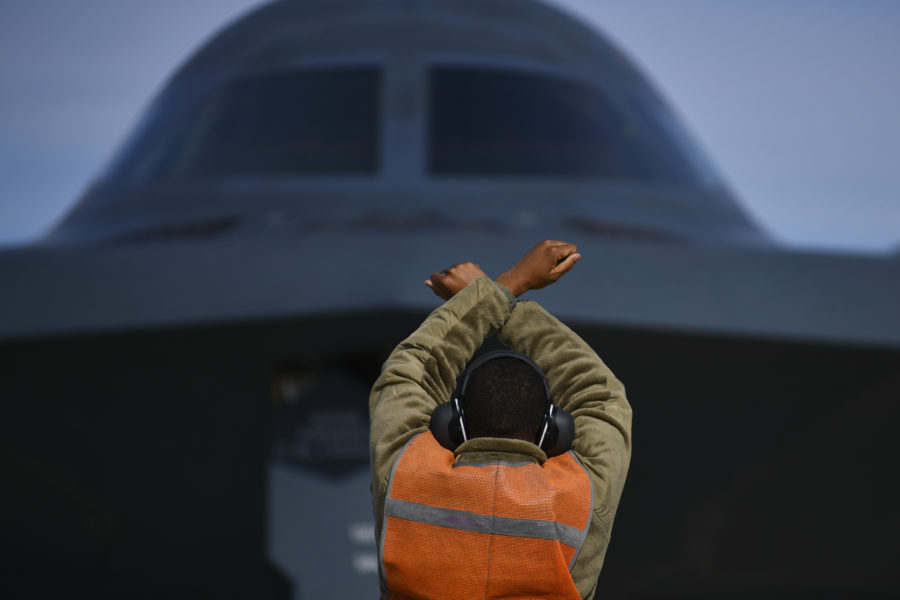Air Force budget documents show B-1 and B-2 bomber spending dwindling through the end of the 2020s, as the service puts priority on the new B-21 and the upgraded B-52. Though the B-1 and B-2 potentially have additional years of service, the near-cutoff in spending in the next five years could make it difficult to keep them credible into the 2030s, should Congress direct that they be retained.
Global Strike Command has said in the last few years it intends to devote its finite manpower and fiscal resources to a two-bomber force—the B-21 and B-52—and retire the B-1 and B-2, which have recorded middling mission capability rates in recent years.
From the small B-2 fleet of just 20 aircraft, GSC can muster about 14 for operations at any given time, the remainder either being in test, depot, or down for maintenance. The B-2’s stealth systems, though improved over the last decade, remain challenging and a voracious consumer of maintenance man-hours. The B-21 is expected to offer a sharp improvement in availability—a “daily flyer” as Chief of Staff Gen. Charles Q. Brown Jr. said at the aircraft’s December 2022 rollout—and require a smaller manpower footprint.
The B-1 fleet was reduced to 45 aircraft less than two years ago, although the maintenance manpower and funding for the 17 retired airplanes was retained to boost the mission capability of those that remain.
The Air Force is requesting $284.9 million for B-2 procurement over the Future Years Defense Plan, running from fiscal year 2024-28. Funding would start at $107.9 million in FY ’24, drop by almost half to $57.16 million in 2025, fall slightly in each of the next two years, and then plummet to $15.78 million in 2028. The “to completion” line in the B-2 procurement account is zero, meaning no further funding is expected to be requested beyond that point.
Research, development, test, and evaluation for the B-2 shows an even more stark dropoff, starting with $87.6 million in 2024, but again falling by more than half to $33.14 million in 2025, followed by just a few thousand dollars a year until 2028, and nothing after that.
Much of the money requested for the B-2 is to upgrade its avionics, communications systems, cockpit displays, weapons, stealth capabilities, training gear, support equipment, and supportability initiatives.
Aircraft that were modified to test the canceled Defensive Management System will be de-modified to make them consistent with the other aircraft in the fleet.
The Air Force will also “study multiple structural, avionics, and engine modifications, as well as advanced weapons integration and advanced communications, that could improve the performance of the aircraft and engines and reduce maintenance man-hours and the logistics footprint of the fleet,” the service said in its budget justification. The B-2 will also receive a cryptological upgrade.
Supportability funding will go toward identifying and fixing specific issues that “drive” non-mission capable rates, USAF said. This will help improve the availability rates for the in-demand bomber.
Funding also supports stealth improvement, called the Low Observable Signature and Supportability Modifications (LOSSM) program. These include improved a broad range of low-observable materials and structures, as well as “radio frequency (RF) diagnostic tools, evaluation systems, and other key support equipment,” the Air Force said. These investments tend to yield a high rate of return on B-2 operating costs and availability, the service noted.
Other improvements include an upgraded identification, friend or foe (IFF) system, training systems and simulator upgrades, and initiatives to address “Diminishing Manufacturing Sources” issues, where parts are hard to get because they are no longer made, or, in the case of software, where systems are at ”end of life” and no longer supportable. The Air Force wants to move toward “a modular, common open system architecture that is sustainable and cyber-resilient.”
Money that was added by Congress in fiscal year 2023 will be used to explore “commercial technologies to include autonomous robotics perimeter defense system, 5G testing support, and advanced software tools.”
The Air Force’s B-1 procurement funding request is $12.8 million in fiscal 2024, falling to $3.31 million in 2025, $4.74 million in 2027, and to around $1 million a year in 2027-28. Over the same period, more was programmed for RDT&E, with $32.68 million across the entire FYDP, but that total is front-loaded to 2024 and 2025, with only a few thousand dollars a year each in 2027 and 2028.
Budget justifications describe the B-1 as an aircraft “with an expected service life beyond 2037.”
The Air Force is constructing a “digital twin” of the B-1B to explore new sustainment technologies developed using digital methods.
Funding items include urgent radio upgrades to prevent the B-1B from losing “secure line of sight, beyond line of sight, and anti-jam communication with ground and air forces,” due to decommissioning of some forms of satellite support and other time-critical changes. Other improvements are being made to cryptological systems and, generally to address Diminishing Manufacturing Sources. Other improvements will require “significant hardware and software development and testing.”
The B-1 will also be provided with gear to carry new weapon systems—particularly, hardware and software for external carriage of hypersonic weapons, although Air Force budget documents did not specify whether those would be the AGM-183 Air-Launch Rapid Response Weapon (ARRW), which the Air Force has since said it will not pursue into production, or the Hypersonic Attack Cruise Missile being developed by Raytheon and Northrop Grumman.

